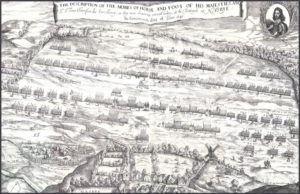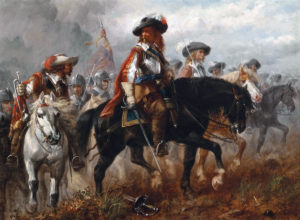By Mark Linnell
The Battle of Naseby took place on the 14th June 1645.
It remains one of the most influential battles in our history to be fought on British soil. I am fortunate enough to live in the area and have enjoyed studying what happened. What strikes me is how the tactics used then shaped our history and continue to be relevant today.
When I run mediation workshops for In Place of Strife or discuss tactics with my clients at Moot Hill, I’m often asked, Who should go first?
Is this who should make the first financial offer? Who should beat their breast and make the first threat? Or is it about another, carefully planned and staged first move?
On the 14th June 1645, two armies were drawn up in a field called Broad Moor, just north west of the village of Naseby.


The Royalist troops, led by the 26-year-old Prince Rupert, were outnumbered by nearly two to one.
Sir Thomas Fairfax, 33, was the commander of the New Model Army. Along with his deputy, Oliver Cromwell, a 45-year-old highly experienced cavalryman, he hatched a plan to send Colonel John Okey and 676 dragoons (mounted riflemen) to advance on Prince Rupert. They were under orders to fire upon the prince and his cavalry as they stood waiting for the battle to commence. Hidden behind the Sulby hedges, within 100 yards of their target, Okey and his men took up their firing positions.
What Fairfax and Cromwell hoped was that the Royalists would make an early charge and commit to battle. This would allow the superior number of Parliamentarian foot soldiers to control the vital ground.
By contrast, Prince Rupert was watching and waiting to see what Fairfax’s first move would be.
The musket fire from Okey’s dragoons made Prince Rupert and his cavalrymen extremely uncomfortable. They charged straight at another Parliamentarian cavalry, led by Colonel Ireton, who received the onslaught at a standstill. Rupert smashed through the Parliamentarian lines and chased the fleeing members of Ireton’s cavalry.


The Royalist horsemen reached their enemy’s camp at Naseby and became pre-occupied trying to plunder it. By the time Prince Rupert turned back to the battlefield, it was too late to save the Royalist infantry and they had no choice but to join the, by then, Royalist retreat.
Rupert lost the day because he was out-thought by Fairfax and Cromwell. Okey’s dragoons made the first move which forced Prince Rupert to react.
There is much more we can learn from the strategies used at the Battle of Naseby. So much so that we run tours of the battlefield where we show you how best to respond if you’re ever involved in a dispute. You’ll learn tactics you can put into action yourself and skills such as how to negotiate in a conflict situation.
If you’d like to learn lessons from history and improve your own chance of being on the side of victory, please get in touch. I’ll be happy to arrange a tour for you and your team.


